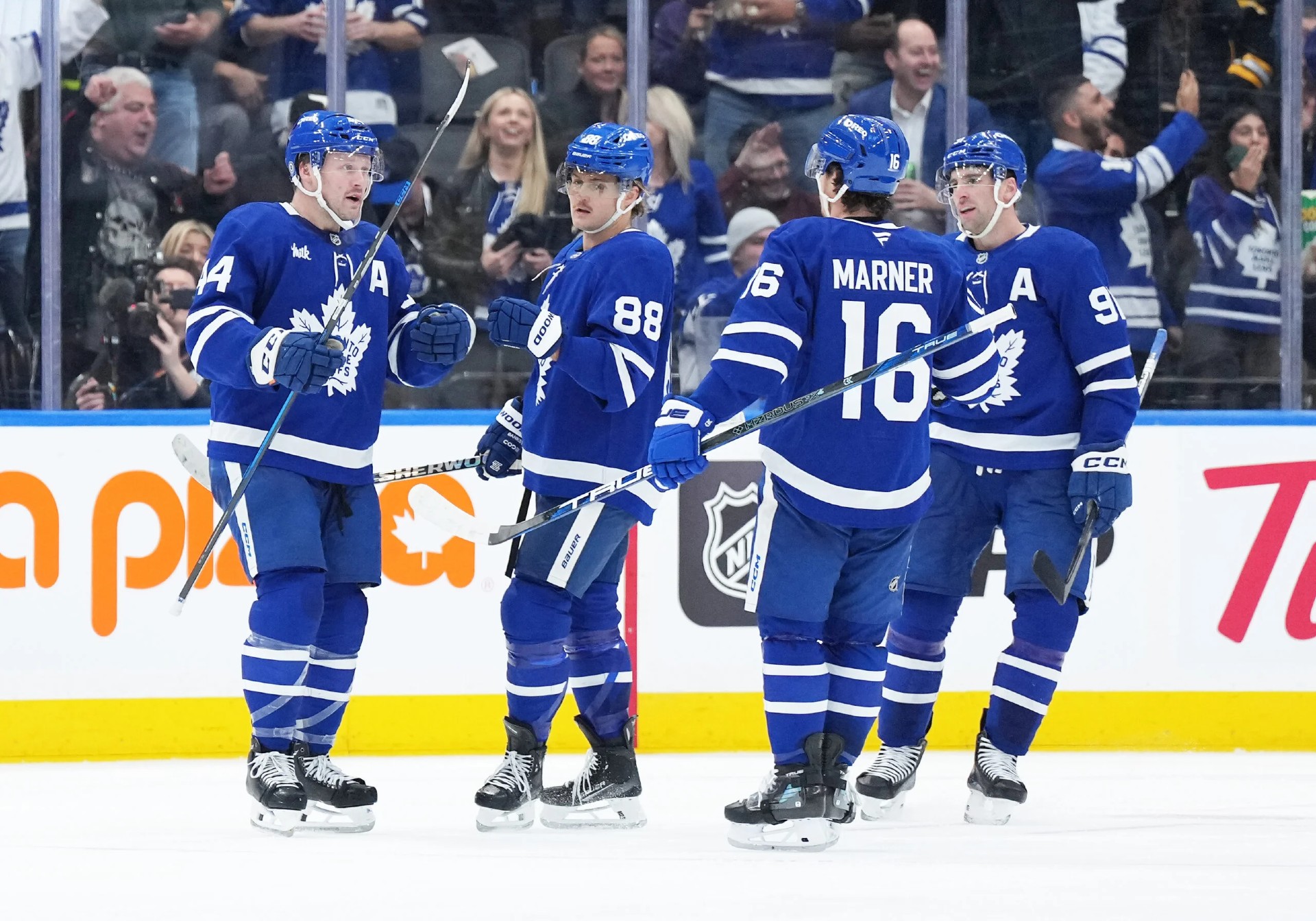In the NHL world, American Thanksgiving traditionally marks the juncture when we start to separate the playoff from the non-playoff teams.
While the manner in which the Maple Leafs got here might be a little surprising – missing nearly half their forward group for an extended period already – it’s no real surprise to see them firmly inside the top 10 league-wide in points percentage (currently seventh).
It is mildly surprising that ranking seventh overall in that department is good enough to place them first in the Atlantic. In an Atlantic Division that has produced four of the past six Presidents’ Trophy winners, it is a huge swing and perhaps indicates the division is as vulnerable as it’s ever been in this era.
There is legitimate reason to believe that the Leafs can get healthy and finally win the Atlantic this season, positioning themselves for the best possible playoff path. At the very least, it is the first time in this era (Covid bubble notwithstanding) that the Leafs don’t feel completely out of the division race at the unofficial quarter pole.
This also marks an excellent opportunity to examine what’s happening across the league. So far this season, three trends in particular are catching my eye.
Dump-in rates are going up.
It is no secret that the Leafs are dumping it in more… but so is the rest of the league. Here is a good thread from Mike Kelly explaining it:
Trend 🧵as most teams approach the 20 game mark…
Teams are dumping pucks in at a higher rate than the past couple of seasons. Copycat league and the defending champs are a test case for overhauling a rush based offensive approach to one more focused on puck management, from…— Mike Kelly (@MikeKellyNHL) November 18, 2024
The key point is that only three teams in the league are dumping the puck in less than they did last season.
The NHL has always been a copycat league, and I don’t think this is only due to the Florida Panthers’ success; Carolina’s success is just as big of a reason. It caught my eye when John Tortorella admitted he’s basically trying to coach his team to play like the Hurricanes. My guess is that he’s not alone in this pursuit.
Unlike the Panthers, the Hurricanes do not have unicorn-type players like Matt Tkachuk and Aleksander Barkov, who are insanely difficult to find. They have really good players – this is not to discredit them – but teams around the league are more likely to have players of Carolina’s quality than the Panthers’. And people around the league are taking notice of how consistently good the Hurricanes are year in and year out, even if they haven’t made it to the Stanley Cup Finals yet (let alone won it all).
At last check, the Leafs are among the league’s top dump-in teams, even when Matthews was playing. They are not only following this trend overall but are taking it to Florida and Carolina levels. It makes sense; if they are going to get where they want to go at playoff time, these are the opponents they will need to conquer.
Across the league, the neutral zone is so tight and difficult to get through cleanly, and the consequences of turning it over in the middle of the rink are so severe that many teams are deciding that they need to put the puck in deep and create turnovers rather than risk getting stood up at the blue line.
The Leafs want to play this way, but so does most of the league. Therefore, it’s about who can do a better job of establishing their forecheck. In Toronto’s worst losses — against the Senators and Columbus, most notably – they couldn’t break out cleanly enough to come close to establishing a forecheck. In their most impressive wins –- the Tampa Bay game stands out, as does the Winnipeg game – the Leafs created many turnovers in the offensive zone and ran over the opposition for long stretches.
As the season progresses and the Leafs start playing some of these top teams more often, establishing a forecheck and breaking out cleanly will be key areas to watch. Everybody is playing this way, but who can impose their will?
Save percentages are down again.
Over the past 10 seasons, here is the NHL’s league average save percentage:
- 2015-16: .915
- 2016-17: .913
- 2017-18: .912
- 2018-19: .910
- 2019-20: .910
- 2020-21: .908
- 2021-22: .907
- 2022-23: .904
- 2023-24: .903
I wonder how much the reduction in traditional workhorse goaltenders is a factor at work here. In the 2015-16 season, ten goalies played at least 60 games, and Pekka Rinne posted the worst save percentage of any of them at .908. The next three goalies all played 58 games. Last season, only three goalies played at least 60 games, and Sergei Bobrovsky ranked fifth at 58. In 2022-23, seven goalies played 60+, and in 2021-22, five did.
I’m not sure there is an overall lack of quality goaltenders in the league, as much as teams want to preserve them for the playoffs. By extension, teams are turning to backups and splitting starts more, and therefore, the overall quality of netminding falls from a league-average perspective.
The Leafs have two excellent goaltenders, so over the course of 82 games, it gives them a distinct advantage on a nightly basis. We are seeing the benefits of their capable tandem so far – they are currently sixth in team save percentage at .909.
However, as we saw with the Bruins over the past few years, a team can only start one goalie at a time in the playoffs. It can lead to hard decisions, drama, second-guessing, and all sorts of headaches.
The Leafs are well ahead of the Panthers and Lightning in terms of team save percentage, but if you had to pick one goalie to win a big game, you’re still taking either Sergei Bobrovsky or Andrei Vasilevskiy before anyone on the Leafs. That’s no knock on the Leafs’ netminders – those are maybe the top two goalies you would select across the entire league to win a playoff game – but it shows the difference between grinding through an 82-game season versus dialing in for the postseason.
The Leafs are in a good spot in that they can platoon their tandem and set themselves up nicely through the regular season to win the division, but when it’s time to buckle down in the playoffs, some of these trends can almost be thrown out the window. The Leafs will face an elite goalie nightly; Toronto could feasibly face a playoff path of Jeremy Swayman, Bobrovsky, and Igor Shesterkin just to make it to the Stanley Cup Finals.
In the meantime, the Leafs are set up really well to play 82 regular-season games with quality, well-above league-average goaltending performances on a nightly basis.
Youth has not been served.
When the “new NHL” arrived in 2006, it was led by Sidney Crosby and Alex Ovechkin, followed shortly afterward by Evgeny Malkin. From there, the young Blackhawks took the mantle, led by Patrick Kane and Jonathan Toews. Four of those five players won championships early in their careers and made immediate headlines for jumping right into the league and dominating from essentially day one.
Before then, young players arriving in the league and not only performing well but winning immediately wasn’t a frequent sight. The above group of players’ success was frankly abnormal, and it probably skewed the thinking, to some degree, on the timeline generally required to win.
Recent winners have changed the perception. Nathan MacKinnon famously “hadn’t won shit” until year nine. After drafting Steven Stamkos first overall, the Tampa Bay Lightning took 12 years to win. The Panthers took 11 years after drafting Aleksander Barkov second overall (they drafted Aaron Ekblad first overall the very next year, too).
Look at most of the top young players entering the league now. The Blackhawks and Sharks are nowhere near respectability, let alone Cup contention. Connor Bedard is experiencing some tough moments at the beginning of year two, and Macklin Celebrini immediately got hurt (but otherwise looks great, all things considered). There’s not much to say about the previous two first-overall picks, either (Juraj Slafkovsky and Owen Power).
If we look at the top-30 scorers in the NHL right now, only two (Tim Stutzle, who is 15th in points, and Jack Hughes, who is 25th) are under 25. A couple of others, like Brady Tkachuk, are 25 on the nose.
Regarding the Leafs and their timeline, Matthews and Marner are 27, while Nylander is 28. All are squarely in the age bracket of the recent top players winning in the league. When we look at the windows for competing and winning, not only are the Leafs’ stars in it, but they also have a lot of runway left (even though it sometimes feels — especially to many Leafs fans — like they’ve been around forever and the window is closing). As much heat as the Leafs’ stars have taken for not winning – and one playoff series win total is definitely worthy of criticism, to be clear – in terms of winning the whole damn thing, they are only just now rounding into the typical age range of recent winners.
The “next wave” will inevitably hit its stride at some point, but the top picks of recent years are currently far away both as players and as teams.
To some degree, this point is relevant to the recent discussions in Toronto regarding rookie call-ups and reasonable expectations for them, particularly as Fraser Minten and Nikita Grebenkin have flashed potential.
At the end of the day, this is a grown man’s league in the playoffs. The Panthers and Vegas each dressed two playoff regulars under 25. The Avalanche dressed three, and two of them were Mikko Rantanen and Cale Makar. The Lightning dressed five and four, respectively, during their runs. You’re going to find a few for sure – the Leafs have Matthew Knies, for instance – but it’s very difficult for young players to succeed at the league’s highest levels in the spring.
The NHL as a whole is trending in the direction of veteran players as well as a physical, forechecking style of hockey. For half a decade, the Leafs actively went against the grain – until the trade deadline rolled around, at which point they altered their style of play for playoff time. They now appear much more in line with the league trends from day one this season. Whether this is a good or bad thing remains to be seen.

































